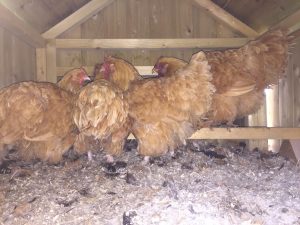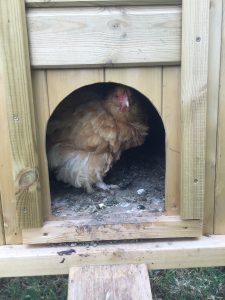Breed Overview
The Black Orpington was originally produced in 1886 by Mr. William Cook at Orpington, in the county of Kent, South East England. He did this from a Black Langshan-Black Minorca-Black Plymouth Rock cross, and this is the original Orpington.
William Cook was aiming to produce a utility bird that was a ‘good winter layer’ and he succeeded. Orpingtons are well known for being dual purpose meat and egg producing birds. Interestingly the Cook family also produced the Orpington breed of duck in the early 1900s, initially in Buff, Chocolate and Blue colors.
Black Orpington Chickens were successfully exported to Australia and thrived. Australorp Farms Limited were a well-known supplier of ‘Australian bred’ Black Orpingtons into the UK.
The Buff (introduced in 1894) and White (introduced in 1889) varieties were produced from crosses other than those which were used to make up the Black Orpington. Cochin blood was introduced into some of the earlier strains of Orpingtons as evidenced by some of the more loosely feathered specimens.
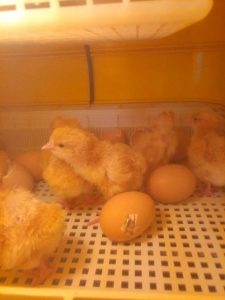
The original Black Orpington came to America in 1890. Blue Orpingtons were then produced from crossing the Black and White varieties in 1923.
Standard and Bantam sized birds are available, but the larger birds are often kept by backyard enthusiasts, describing them as ‘docile’, due to their calm and quiet behavior.
We keep Orpingtons as pets on our farm and we absolutely love their friendly caring nature.
Appearance (Part 1)
Orpington Chickens are large, tall, upright and graceful birds with quite small wings carried close to the body. The tail is medium length and full, carried almost upright to the body. Tail feathers are easily damaged by birds squeezing through small gaps, thus door openings to runs and cages need to be wide to avoid feather loss.
Orpingtons don’t like flying and rarely run off, so low fencing of 4 feet (1.3 metres) is usually adequate to contain the flock.
These large birds are highly valued for their meat and fairly consistent egg laying ability, capable of producing up to 200 large eggs a year.
Despite their docile manner, Orpingtons like to stretch their legs and thrive as free-range foraging chickens, but can also do well in more confined conditions. Orpingtons prefer being outside foraging and will happily stay out for the whole day, from dawn to dusk, enjoying a diet of fallen fruit, seeds, insects, weeds and grubs.
Orpington Chicken Colors
Standard colors are Buff, Ermine, Cuckoo, Jubilee (first public appearance in 1897, the Diamond Jubilee of Queen Victoria), Partridge, Red, Blue, Gold Laced, Silver Laced, Spangled, Lavender, Lemon and Chocolate.
The Buff Orpington is one of the most popular colors of bird and is widely kept and shown by enthusiasts in the USA, UK and Australia.
Bantams
Bantam Orpingtons are available in all the standard colors except for cuckoo, jubilee and spangled.
Orpington bantams first appeared in 1900 (Buff color) imported from Germany, but were not initially very popular.
The Black Orpington bantam was introduced in 1929 by John Burdett and first appeared at the 1936 (UK) Dairy Show.
The White bantam was then introduced next, slightly later in 1946 and appeared at the 1950 (UK) Dairy Show.
Then the Blue bantam was only first exhibited in 1953 at Bradford in Yorkshire (UK).
In terms of height, the Bantam Orpingtons look very small next to Standard birds, typically being considerably less than half the height of a Standard bird.
Weights
Bantam males typically weigh around 2 Kg (4.4 lbs.) and females around 1.6 Kg (3.52 lbs.).
Standard Orpingtons are quite large, with hens weighing around 3.6 Kg (8 lbs.) and cockerels 4.6 Kg (10 lbs.).
Orpingtons have a habit of ‘fluffing up’ their feathers and this makes them look even larger!
Orpington Chicken Eggs
Orpington eggs are usually large, weighing around 2.2 ounces (65 grams).
Egg production is between 180 to 280 eggs per year. So on average about 4-5 per week.
Color
Eggs are light brown to dark brown
When do they start laying eggs?
Chicks mature slowly and hens start laying from 6 months onwards.
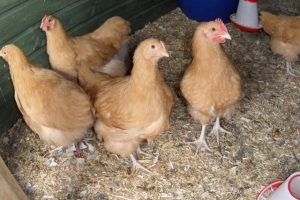
Orpington Characteristics
Classification
Heavy / Soft feather
Origin
Great Britain
Temperament / Are they good as pets?
Orpingtons chickens are friendly, calm and docile if raised by hand and are the ideal chicken breed for first-time backyard farmers.
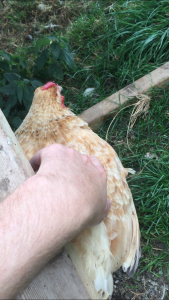
Orpingtons are hardy birds and can tolerate cold temperatures for a few weeks each year, but love to ‘sunbathe’ in the summer.
For a large size bird, they have small beaks. Orpingtons are noted for their friendly, confident manner and despite their size when fully grown, can make excellent pets.
As with all chickens, they do not enjoy being pulled or prodded by children, so careful supervision is required.
Orpington chickens will quickly become used to humans if raised by hand as chicks.
One cockerel for every 5 hens is a the best ratio.
Orpingtons love to actively forage outside ‘far and wide’ in warmer months and require large spaces for this. These are hardy, disease resistant chickens and considered fairly ‘low maintenance’.
How do I tame Orpington chickens?
The best way to tame a chicken is to handle it gently when it is still young; this gets your chickens used to people.
If you have older chickens that need taming, try feeding them out of your hand regularly. Orpington chickens are noted for their easy-going temperament and gentle nature.
A good idea to train them to regularly return to the chicken coop each night, is to feed them before dusk regularly.
How many do I need to buy?
2 chickens are the absolute minimum you need for a flock, we recommend around 5-6 as a great small flock number.
It is hard to find reputable breeders of Orpingtons.
How much space do Orpingtons need?
Orpingtons ideally require a large, secure backyard to do well, but smaller backyards can accommodate a small flock.
Standard birds are large size and can be confined in small chicken coops for short periods.
Ideally 5 square feet minimum per mature bird in a coop and around 20 square feet minimum per bird in a run.
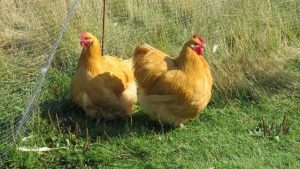
Orpington’s require 12-14 inches roost space width. By width I mean wing to wing space. As you can see in the photo, we only fit 4 Orpington’s along our 60 inch (152cm) roost bars.
Orpington Chickens love being outside exploring and foraging for food, so must have good outside access to prevent boredom.
These chickens are very poor fliers, so high -level containment fencing is not essential, but protection from predators is required.
Will they mix with my other chickens?
Despite their large bodies, Orpingtons are not aggressive birds, they are very easy going and will get along well with other breeds of chickens.
They are a great breed that will mix well into any flock. We at 8 different breeds within our flock and have zero issues. They are a great all round breed.
Some backyard chicken keepers have a few Orpingtons solely for their striking looks and calm manner. It is vital the flock is not too closely confined and there is adequate room to forage, explore outside and prevent boredom.
Because Orpingtons are so docile, they may be ‘picked on’ and bullied by other more aggressive breeds of chickens; this can be particularly noticeable at feeding times or when bored and closely confined for too long.
Feeding
What should I feed them?
When you first get your chickens home you should feed them growers mash, as it has a higher percentage of protein (19%) and is refined so that it can be easily ingested.
You should feed them growers mash up until 6 weeks where they should be fed chicken pellets which is just feed in pellet form, this has between 15-16% protein.
At 22 weeks your chickens need more nutrients to help with egg production so slowly start feeding them layers mash or pellets which has around 16% protein.
Chickens will need access to fresh drinking water all day long, they will prefer cool drinking water, no one is quite sure why maybe it’s a prehistoric throwback. It is important to have the feed and water at the proper height for all birds in the pen.
Ideally feed and water should be at back level. If the water is too low down, chickens may scratch litter into it and the water will go bad quickly.
Your chickens also need grit to help with egg production, so make sure there is always some within easy access for them at all times.
Orpingtons are excellent foragers and will supplement their feed intake by hunting outside for insects, slugs, snails, seeds and bugs to eat.
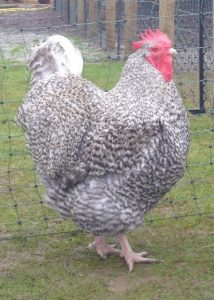
How much should I feed them?
Orpingtons are large birds, but young chicks should not be overfed to try and accelerate growth, as damage to their bone structure will occur.
Fully grown they eat anywhere between 4.2oz (120g) and 6oz (170g) a day. On average breeders feed their chickens 5 oz (140g) a day, depending on the size of the birds and whether they are outside foraging.
Start by feeding them this and then adjust the weight of feed around how much they consume. You can leave the feed in a feeder for them to eat whenever they please or you can give them set meal times.
Your Orpingtons also need grit to help with laying those lovely large brown eggs, so make sure there is always some in easy reach for them at all times.
What can’t they eat?
Chocolate and beans are the two main foods that shouldn’t be eaten by chickens. The phytohemagglutinin in beans can lead to fatalities and the theobromine in chocolate can cause heart problems.
Moldy food that has bad bacteria in it should not be fed to chickens as it can make them very unwell. For this reason, it is illegal to feed your chickens leftovers in the UK.
What do I need to keep chickens?
The most essential item you need to keep chickens is a coop, which should ideally be 0.5 m2 or 5 square feet per chicken. Their run needs 20 square feet (1.9 m2) per chicken. In the coop they should have a perch to sleep on and a wooden laying box for their eggs.
Orpingtons roost at a height of between 2 feet to 4 feet (60cms – 120cms) off the ground, so this is a good height to erect their perch.
A coop like the OverEz Medium for 3-4 birds at 18sqft, would be brilliant.
The OverEz Large would be perfect for 6 Orpingtons at just over 30sqft.
You should invest in a sunken fence [the bottom is dug into the ground] to go over and around the coop to keep them safe at night.
Find a water bowl which they can’t stand in or push over and place it in the shade, so the water doesn’t get too warm.
Feed and water for Orpingtons are best placed off the ground, at around the ‘back’ height of the bird. Raised feed and water bowl holders are easily obtained.
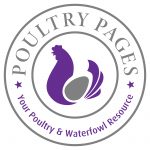
Orpington Breed F.A.Q’s
How often do Orpington chickens lay eggs?
My Orpington chickens will lay 1 egg every 2 days. Or 15-20 eggs per month.
How long do Orpington chickens live?
Orpingtons have a life expectancy of between 6-9 years. Life span is dependent on the living conditions and the diet of the bird. Free range Orpington’s will live for longer as they get plenty of exercise and can forage for ‘fresh healthy’ insects and grubs to eat!
Do Orpington chickens fly?
Yes they can fly, but not very high and not very far. They can get about 1ft off the ground and fly only a few metres in distance.
THE ORPINGTON BREED STANDARDS (Courtesy The Orpington Club)
Carriage: Bold, upright and graceful; that of an active fowl.
Type: Body deep, broad and cobby. Back nicely curved with a somewhat short, concaved outline. Saddle wide and slightly rising, with full hackle. Breast broad, deep and well rounded, not flat. Wings small, nicely formed and carried closely to the body, the ends almost hidden by the saddle hackle. Tail rather short, compact, flowing and high, but by no means a squirrel tail.
Head: Small and neat, fairly full over the eyes. Beak strong and nicely curved. Eyes large and bold. Comb single, small, firmly set on head, evenly serrated and free from side sprigs. In the black variety, comb may be single or rose, the latter small, straight and firm, full of fine work or small spikes, level on top (not hollow in centre), narrowing behind to a distinct peak lying well down to the head (not sticking up). Face smooth. Wattles of medium length, rather oblong and nicely rounded at the bottom. Ear-lobes small and elongated.
Neck: Of medium length, curved, compact and full with full hackle.
Legs and feet: Legs short and strong, the thighs almost hidden by the body feathers, well set apart. Toes, four, straight and well spread.
Plumage: Fairly profuse but close, not soft, loose and fluffy as in the Cochin, or close and hard as in the Game Fowl.
Handling: Firm.
Female: The general characteristics are similar to those of the male. Her cushion should be wide but almost flat, and slightly rising to the tail, sufficient to give back a graceful appearance with an outline approaching concave.
COLOUR
The Blue
Male plumage: Hackles, saddle, wing bow, back and tail dark slate blue. Remainder medium slate blue, each feather to show lacing of darker shade as on back.
Female plumage: Medium slate blue, laced with darker shade all through, except head and neck, dark slate blue.
In both sexes: Beak black. Eyes black or very dark brown, black preferred. Comb, face, wattles and ear-lobes bright red. Legs and feet black or blue. Toe-nails white.
The Black
Male and female plumage: Black with a green sheen.
In both sexes: Beak, etc as in the blue. Soles of feet white.
The White
Male and female plumage: Pure snow white.
In both sexes: Beak, legs, feet and skin white. Eyes, face, ear-lobes and wattles red.
The Jubilee
(first appeared in 1897, the Diamond Jubilee of Queen Victoria)
Beak, legs and feet, white. Earlobes red, face, comb and wattles red. Eyes red. Toe nails and skin white.
Plumage of the cock: Ground colour mahogany of a bright shade, and not dark nor maroon. Hackles and back, mahogany, with black centre stripe, mahogany shaft and white tip. Breast, thighs and fluff, mahogany, with black spangle and white tip, the three colours clean and distinct and showing in equal proportions, avoiding a ticked effect on the one hand, and a blotchy effect on the other. Wings: Bow similar to hackles; bar, black; secondaries mahogany, black and white; primaries similar but, more white allowed. Tail sickles white, or black and white, or black, white and mahogany; coverts, black edged with mahogany and tipped with white.
Plumage of the hen: Hackle to match that of the cock. Body, thighs and fluff mahogany with spangles and white tips, similar to the breast of the cock. Wings as the body, but with primaries to match those of the cock. Tail as in the cock.
The Spangled
Beak, black, white or slightly mottled. Eyes, red or brown, red preferred. Comb, face, wattles and earlobes, red. Legs and feet, black and white, mottled as evenly as possible. Toenails, skin, white.
Plumage of the cock: Hackles, black with white tips. Back black, slightly ticked with white. Breast, thighs and fluff, black with white spangles, the two colours showing in equal proportions, avoiding a ticked effect on the one hand, and a blotchy effect on the other. Wings bow similar to back; bar, black; secondaries and primaries black and white, but more white allowed in the primaries or flights. Tail black and white; the sickles and the coverts black with white tips.
Plumage of the hen: Neck, wings (flights only) and tail, similar to those parts of the cock. Remainder the same as the breast of the cock, the effect to be uniform throughout the bird.
(Note, in BOTH sexes the black should have a bright gloss, beetle green sheen, and the white should be pure and bright. The two colours should be distinct and not running into each other.)
The Cuckoo
Beak white. Eyes red. Comb, face, wattles and earlobes, red. Legs and feet white. Toenails and skin white.
Plumage of both sexes: Blue-grey (light shade) ground, each feather barred across with blue-black (dark shade) the markings in keeping with the size of the feather.

